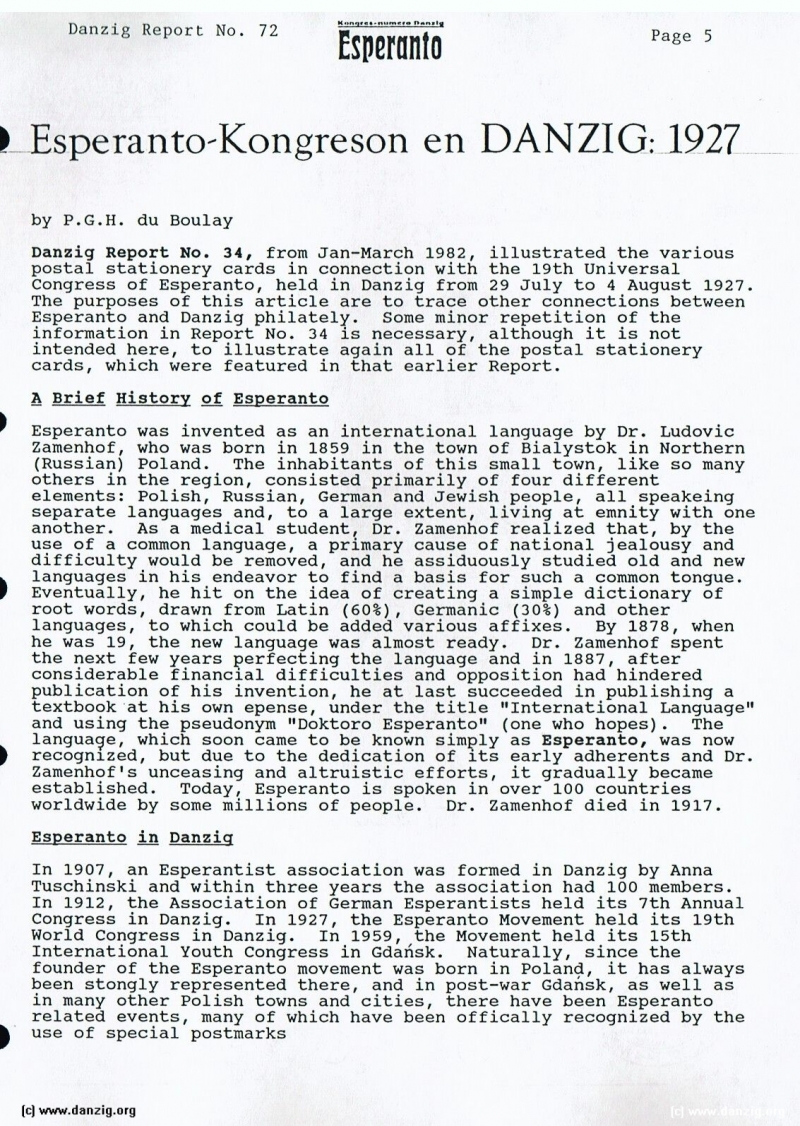
Esperanto-Kongreson en DANZIG: 1927
by P.G.H. du Boulay
Danzig Report No. 34, from Jan-March 1982, illustrated the various postal stationery cards in connection with the 19th Universal Congress of Esperanto, held in Danzig from 29 July to 4 August 1927. The purposes of this article are to trace other connections between Esperanto and Danzig philately. Some minor repetition of the information in Report No. 34 is necessary, although it is not intended here, to illustrate again all of the postal stationery cards, which were featured in that earlier Report.
A Brief History of Esperanto
Esperanto was invented as an international language by Dr. Ludovic Zamenhof, who was born in 1859 in the town of Bialystok in Northern (Russian) Poland. The inhabitants of this small town, like so many others in the region, consisted primarily of four different elements: Polish, Russian, German and Jewish people, all speakeing separate languages and, to a large extent, living at emnity with one another. As a medical student, Dr. Zamenhof realized that, by the use of a common language, a primary cause of national jealousy and difficulty would be removed, and he assiduously studied old and new languages in his endeavor to find a basis for such a common tongue. F Eventually, he hit on the idea of creating a simple dictionary of root words, drawn from Latin (60%), Germanic (30%) and other languages, to which could be added various affixes. By 1878, when he was 19, the new language was almost ready. Dr. Zamenhof spent the next few years perfecting the language and in 1887, after considerable financial difficulties and opposition had hindered publication of his invention, he at last succeeded in publishing a textbook at his own epense, under the title “International Language” and using the pseudonym “Doktoro Esperanto” (one who hopes). The langua9e, which soon came to be known simply as Esperanto, was now recognized, but due to the dedication of its early adherents and Dr. Zamenhof’s unceasing and altruistic efforts, it gradually became established. Today, Esperanto is spoken in over 100 countries worldwide by some millions of people. Dr. Zamerihof died in 1917.
Esperanto in Danzig
In 1907, an Esperantist association was formed in Danzig by Anna Tuschinski and within three years the association had 100 members. In 1912, the Association of German Esperantists held its 7th Annual Congress in Danzig. In 1927, the Esperanto Movement held its 19th World Congress in Danzig. In 1959, the Movement held its 15th International Youth Congress in Gdansk. Naturally, since the founder of the Esperanto movement was born in Poland, it has always been stongly represented there, and in post-war Gdansk, as well as in many other Polish towns and cities, there have been Esperanto related events, many of which have been offically recognized by the use of special postmarks
Danzig Report Vol. 1 - Nr. 72 - July - August - September - 1991, Page 5.
Hits: 4328
Added: 30/06/2015
Copyright: 2024 Danzig.org

